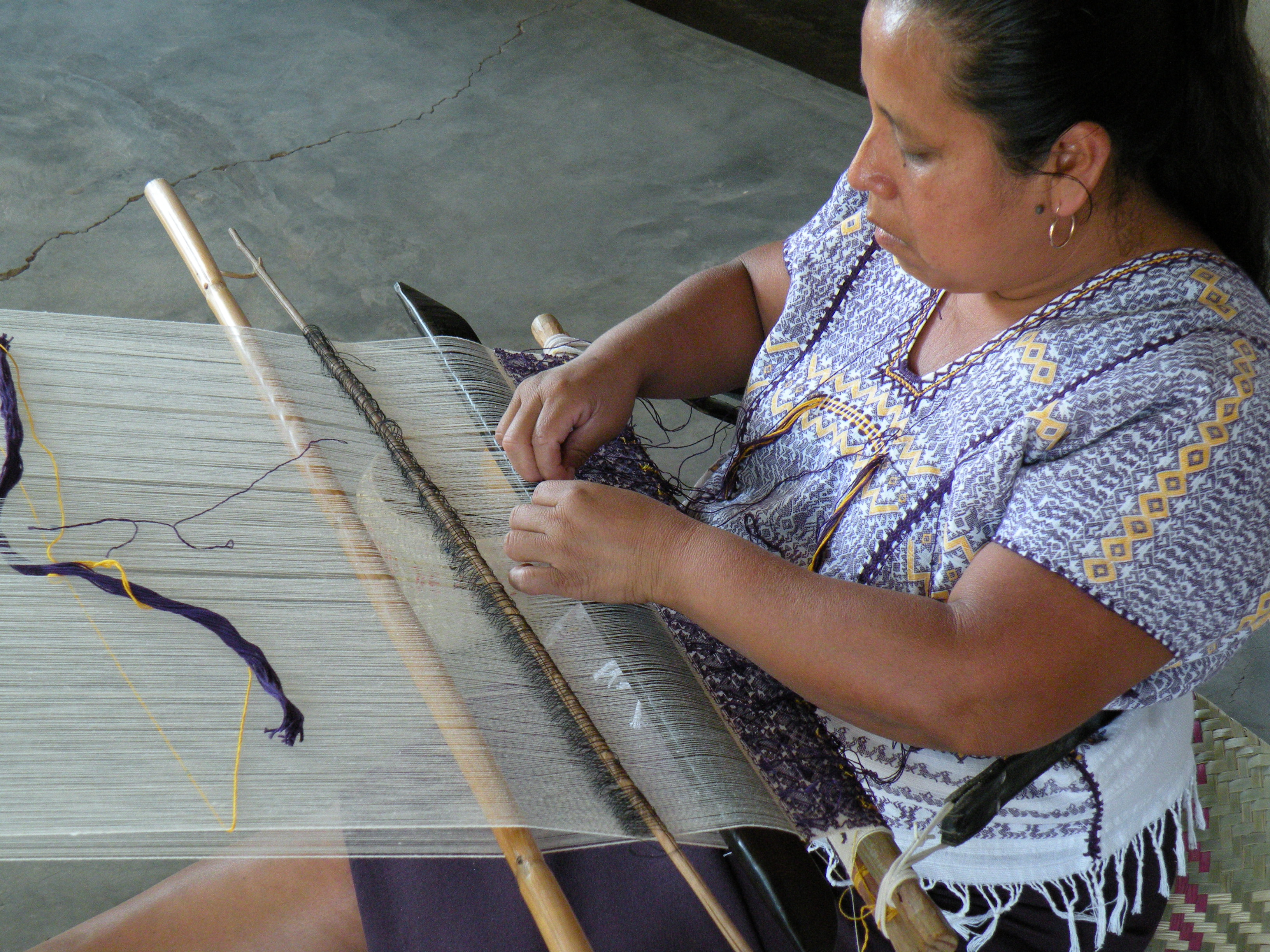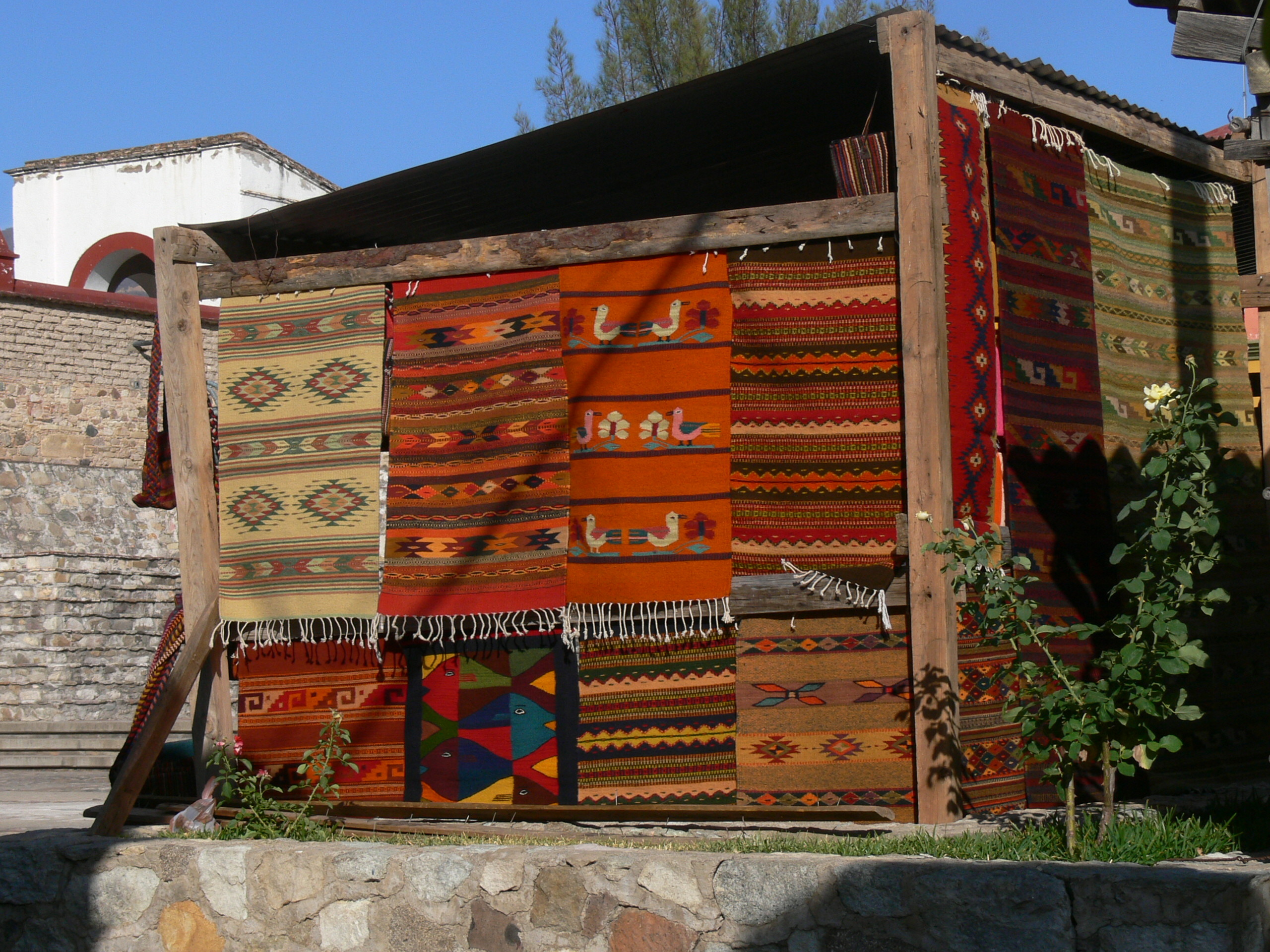The weaving tradition of Oaxaca
With my assignments all out of the way and work quietening down a bit, I've realised it's less than two months until I fly out for Mexico. With that in mind, it's about time I shared some of the tradition of the area and a little bit of what I might be learning over there.
While I'll be doing both weaving and embroidery residencies (three weeks of each), I've found it pretty hard to find information on the embroidery, even the education director at the textile museum in Oaxaca said there's not much written about it, so I might be better visiting them when I'm there to find out more.
Weaving is a different story – it's been part of the Oaxaca tradition since before the Aztecs. There are no textiles surviving from this period, but there are certainly images on murals, carvings and manuscripts showing women weaving on a backstrap loom, which is what I'll be learning on. I'm pretty sure I'll be working on a narrower and less threaded loom than the one shown below – I'm starting from nothing in terms of weaving.
The traditional materials used for weaving were native cottons, rabbit fur and feathers. That changed with the introduction of wool by the Spanish, who also brought with them new dyestuffs, embroidery techniques and, most importantly, the treadle loom, which enabled the production of much larger pieces of cloth.
Going hand in hand with the fibres used for weaving are the dyes used to colour them. Cochineal is the most prized red dye and much of it is produced in Oaxaca. Cochineal is a parasite that lives on the cactus plant and when used alone or mixed with other substances, can produce dyes from one third of the colour spectrum. Before the introduction of synthetic dyes, cochineal was Mexico's second largest export after silver. The Spanish forced a monopoly on its production during the colonial period and the punishment if you were caught smuggling cochineal was death. While I won't be doing the dye residency at Arquetopia, there are certainly options for me to do short courses at other places while I'm there.
I'll also have plenty of time to get outside Oaxaca to visit some of the smaller towns in the area. Many of them are known for particular types of weaving with up to 90 per cent of a town's income being derived from the craft. Probably the most well-known of these towns is Teotitlán del Valle, famous for its woven rugs. These are made on treadle looms, mostly from wool, and the community is returning to using natural dyes, as the importance of sustainability is recognised. Many are woven using traditional designs, although some weavers mix that up with more modern ones.
As with the production of traditional textiles everywhere, the next generation aren't always keen to carry on the work of their parents, many preferring to move to the cities to earn better money. It seems that the towns around Oaxaca are doing better than most in this respect and it will be interesting to see it for myself.
A fabulous resource I've come across in my research has been the documentary Woven Lives, which profiled many of these weaving communities along with the products they're making and the processes they use. It also included a segment on the textile museum at Oaxaca – something else I'm looking forward to visiting.
Lastly, for those of you on Pinterest I've also made a Oaxaca Pinterest board. It's a bunch of images I've been collecting about the textiles from Oaxaca, wider Mexico, and some designers and artists who've been inspired by them.
While I'll be doing both weaving and embroidery residencies (three weeks of each), I've found it pretty hard to find information on the embroidery, even the education director at the textile museum in Oaxaca said there's not much written about it, so I might be better visiting them when I'm there to find out more.
Weaving is a different story – it's been part of the Oaxaca tradition since before the Aztecs. There are no textiles surviving from this period, but there are certainly images on murals, carvings and manuscripts showing women weaving on a backstrap loom, which is what I'll be learning on. I'm pretty sure I'll be working on a narrower and less threaded loom than the one shown below – I'm starting from nothing in terms of weaving.
 |
| Nicolasa Pascual is a weaver from San Bartolo Yautepec, Oaxaca. Image via Norma Hawthorne's Oaxaca Cultural Navigator site, taken by Eric Chavez Santiago, Director of Education, Museo Textil de Oaxaca. |
Going hand in hand with the fibres used for weaving are the dyes used to colour them. Cochineal is the most prized red dye and much of it is produced in Oaxaca. Cochineal is a parasite that lives on the cactus plant and when used alone or mixed with other substances, can produce dyes from one third of the colour spectrum. Before the introduction of synthetic dyes, cochineal was Mexico's second largest export after silver. The Spanish forced a monopoly on its production during the colonial period and the punishment if you were caught smuggling cochineal was death. While I won't be doing the dye residency at Arquetopia, there are certainly options for me to do short courses at other places while I'm there.
I'll also have plenty of time to get outside Oaxaca to visit some of the smaller towns in the area. Many of them are known for particular types of weaving with up to 90 per cent of a town's income being derived from the craft. Probably the most well-known of these towns is Teotitlán del Valle, famous for its woven rugs. These are made on treadle looms, mostly from wool, and the community is returning to using natural dyes, as the importance of sustainability is recognised. Many are woven using traditional designs, although some weavers mix that up with more modern ones.
 |
| Textiles from Teotitlán de Valle by Wolfgang Sauber via Wikimedia Commons |
A fabulous resource I've come across in my research has been the documentary Woven Lives, which profiled many of these weaving communities along with the products they're making and the processes they use. It also included a segment on the textile museum at Oaxaca – something else I'm looking forward to visiting.
Lastly, for those of you on Pinterest I've also made a Oaxaca Pinterest board. It's a bunch of images I've been collecting about the textiles from Oaxaca, wider Mexico, and some designers and artists who've been inspired by them.
